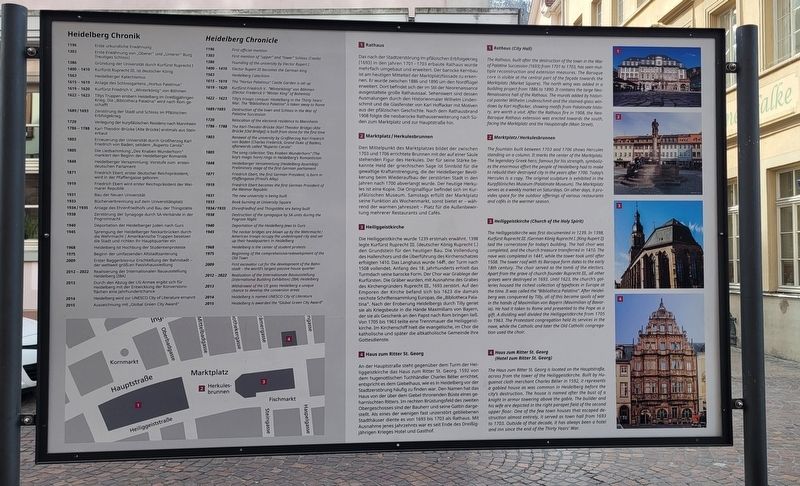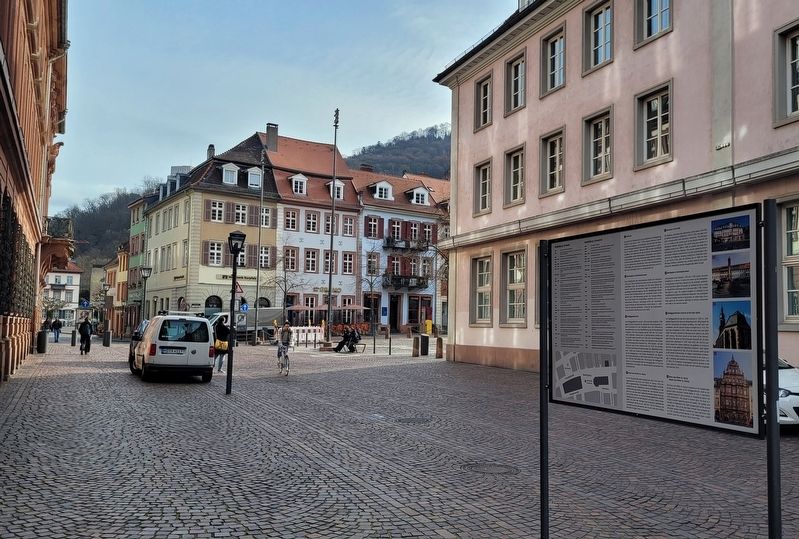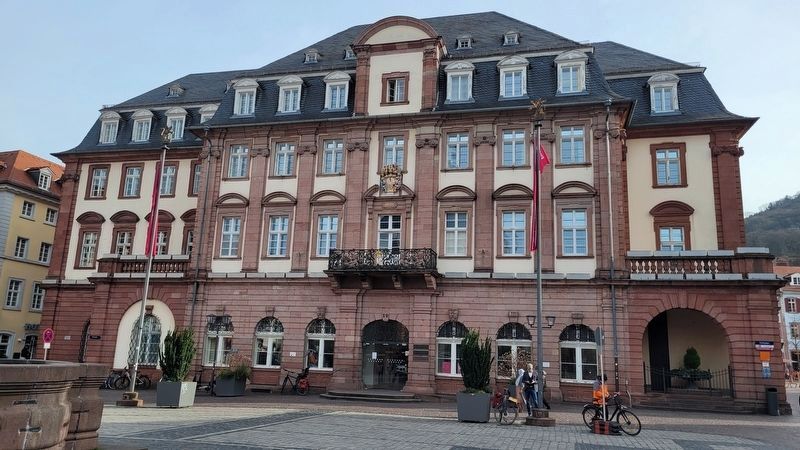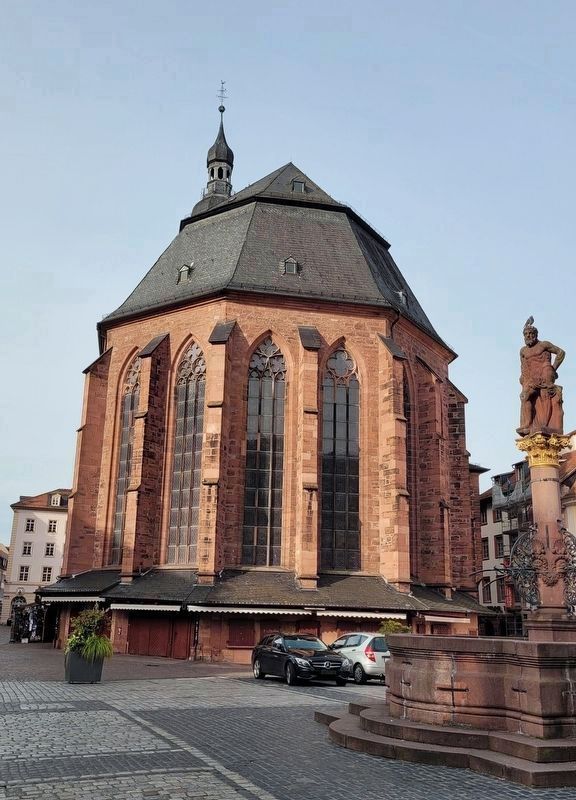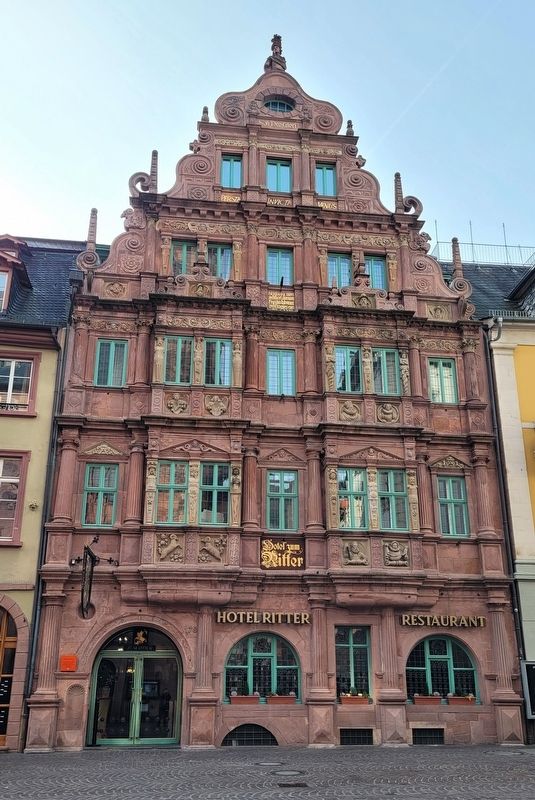Altstadt in Heidelberg, Baden-Württemberg, Germany — Central Europe
Heidelberg Chronik / Heidelberg Chronicle
1196 Erste urkundliche Erwähnung
1303 Erste Erwähnung von „Oberer" und „Unterer" Burg (heutiges Schloss)
1386 Gründung der Universität durch Kurfürst Ruprecht I
1400-1410 Kurfürst Ruprecht III. ist deutscher König
1563 Heidelberger Katechismus
1615-1619 Anlage des Schlossgartens,Hortus Palatinus"
1619-1620 Kurfürst Friedrich V. wird „Winterkönig" von Böhmen
1622-1623 Tillys Truppen erobern Heidelberg im Dreißigjährigen Krieg. Die „Bibliotheca Palatina" wird nach Rom geschafft
1689/1693 Zerstörung der Stadt und Schloss im Pfälzischen Erbfolgekrieg
1720 Verlegung der kurpfälzischen Residenz nach Mannheim
1786-1788 Karl-Theodor-Brücke (Alte Brücke) erstmals aus Stein erbaut
1803 Erneuerung der Universität durch Großherzog Karl Friedrich von Baden, seitdem „Ruperto Carola"
1805 Die Liedsammlung „Des Knaben Wunderhorn" markiert den Beginn der Heidelberger Romantik
1848 Heidelberger Versammlung: Vorstufe zum ersten deutschen Parlament
1871 Friedrich Ebert, erster deutscher Reichspräsident, wird in der Pfaffengasse geboren
1919 Friedrich Ebert wird erster Reichspräsident der Weimarer Republik
1931 Bau der Neuen Universität
1933 Bücherverbrennung auf dem Universitätsplatz
1934/1935 Anlage des Ehrenfriedhofs und Bau der Thingstätte
1938 Zerstörung der Synagoge durch SA-Verbände in der Pogromnacht
1940 Deportation der Heidelberger Juden nach Gurs
1945 Sprengung der Heidelberger Neckarbrücken durch die Wehrmacht / Amerikanische Truppen besetzen die Stadt und richten ihr Hauptquartier ein
1968 Heidelberg ist Hochburg der Studentenproteste
1975 Beginn der umfassenden Altstadtsanierung
2009 Erster Baggerbiss zur Erschließung der Bahnstadtder seinerzeit weltweit größten Passivhaussiedlung
2013 Durch den Abzug der US-Armee ergibt sich für Heidelberg mit der Entwicklung der Konversionsflächen eine Jahrhundertchance
2014 Heidelberg wird zur UNESCO City of Literature ernannt
2015 Auszeichnung mit „Global Green City Award"
1 Rathaus
Das nach der Stadtzerstörung im pfälzischen Erbfolgekrieg (1693) in den Jahren 1701-1703 erbaute Rathaus wurde mehrfach umgebaut und erweitert. Der barocke Kernbau ist am heutigen Mittelteil der Marktplatzfassade zu erkennen. Er wurde
zwischen 1886 und 1890 um den Nordflügel erweitert. Dort befindet sich der im Stil der Neorenaissance ausgestaltete große Rathaussaal. Sehenswert sind dessen Ausmalungen durch den Historienmaler Wilhelm Lindenschmit und die Glasfenster von Karl Hoffacker mit Motiven aus der pfälzischen Geschichte. Nach dem Rathausbrand 1908 folgte die neobarocke Rathauserweiterung nach Süden zum Marktplatz und zur Hauptstraße hin.
2 Marktplatz/Herkulesbrunnen
Den Mittelpunkt des Marktplatzes bildet der zwischen 1703 und 1706 errichtete Brunnen mit der auf einer Säule stehenden Figur des Herkules. Der für seine Stärke bekannte Held der griechischen Sage ist Sinnbild für die gewaltige Kraftanstrengung, die der Heidelberger Bevölkerung beim Wiederaufbau der zerstörten Stadt in den Jahren nach 1700 abverlangt wurde. Der heutige Herkules ist eine Kopie. Die Originalfigur befindet sich im Kurpfälzischen Museum. Samstags erfüllt der Marktplatz seine Funktion als Wochenmarkt, sonst bietet er - während der warmen Jahreszeit - Platz für die Außenbewirtung mehrerer Restaurants und Cafés.
3 Heiliggeistkirche
Die Heiliggeistkirche wurde 1239 erstmals erwähnt. 1398 legte Kurfürst Ruprecht III. (deutscher König Ruprecht I.) den Grundstein für den heutigen Bau. Die Vollendung des Hallenchors und die Überführung des Kirchenschatzes erfolgten 1410. Das Langhaus wurde
1441, der Turm nach 1508 vollendet. Anfang des 18. Jahrhunderts erhielt das Turmdach seine barocke Form. Der Chor war Grablege der Kurfürsten. Die Gräber wurden, mit Ausnahme des Grabes des Kirchengründers Ruprecht III., 1693 zerstört. Auf den Emporen der Kirche befand sich bis 1623 die damals reichste Schriftensammlung Europas, die „Bibliotheca Palatina". Nach der Eroberung Heidelbergs durch Tilly geriet sie als Kriegsbeute in die Hände Maximilians von Bayern, der sie als Geschenk an den Papst nach Rom bringen ließ. Von 1705 bis 1963 teilte eine Trennmauer die Heiliggeistkirche. Im Kirchenschiff hielt die evangelische, im Chor die katholische und später die altkatholische Gemeinde ihre Gottesdienste.
4 Haus zum Ritter St. Georg
An der Hauptstraße steht gegenüber dem Turm der Heiliggeistkirche das Haus zum Ritter St. Georg. 1592 von dem hugenottischen Tuchhändler Charles Bélier errichtet, entspricht es dem Giebelhaus, wie es in Heidelberg vor der Stadtzerstörung häufig zu finden war. Den Namen hat das Haus von der über dem Giebel thronenden Büste eines geharnischten Ritters. Im rechten Brüstungsfeld des zweiten Obergeschosses sind der Bauherr und seine Gattin dargestellt. Als eines der wenigen fast unzerstört gebliebenen Stadthäuser diente es von 1693 bis 1703 als Rathaus. Mit Ausnahme jenes Jahrzehnts war es seit Ende des Dreißigjährigen Krieges Hotel und
Gasthof.
1196 First official mention
1303 First mention of "upper" and "lower" Schloss (Castle)
1386 Founding of the university by Elector Rupert I.
1400-1410 Elector Rupert III becomes the German king
1563 Heidelberg Catechism
1615-1619 The "Hortus Palatinus" Castle Garden is set up
1619-1620 Kurfürst Friedrich V. "Winterkönig" von Böhmen (Elector Frederick V "Winter King" of Bohemia)
1622-1623 Tilly's troops conquer Heidelberg in the Thirty Years' War. The "Bibliotheca Palatina" is taken away to Rome
1689/1693 Destruction of the town and Schloss in the War of Palatine Succession
1720 Relocation of the electoral residence to Mannheim
1786-1788 The Karl-Theodor-Brücke (Karl Theodor Bridge) (Alte Brücke [Old Bridge]) is built from stone for the first time
1803 Renewal of the university by Großherzog Karl Friedrich von Baden (Charles Frederick, Grand Duke of Baden), afterwards called "Ruperto Carola"
1805 The song collection "Des Knaben Wunderhorn" (The boy's magic horn) rings in Heidelberg's Romanticism
1848 Heidelberger Versammlung (Heidelberg Assembly): Preliminary stage of the first German parliament
1871 Friedrich Ebert, the first German
President, is born in Pfaffengasse (Priest's Alley)
1919 Friedrich Ebert becomes the first German President of the Weimar Republic
1931 The new university is being built
1933 Book burning at University Square
1934/1935 Ehrenfriedhof and Thingstätte are being built
1938 Destruction of the synagogue by SA units during the Pogrom Night
1940 Deportation of the Heidelberg Jews to Gurs
1945 The neckar bridges are blown up by the Wehrmacht/ American troops occupy the undestroyed city and set up their headquarters in Heidelberg
1968 Heidelberg is the center of student protests
1975 Beginning of the comprehensive redevelopment of the Old Town
2009 First excavator cut for the development of the Bahnstadt - the world's largest passive house quarter
2012-2022 Realization of the Internationale Bauausstellung (International Building Exhibition) (IBA) Heidelberg
2013 Withdrawal of the US gives Heidelberg a unique chance to develop the conversion areas
2014 Heidelberg is named UNESCO City of Literature
2015 Heidelberg is awarded the "Global Green City Award"
1 Rathaus (City Hall)
The Rathaus, built after the destruction of the town in the War of Palatine Succession (1693) from 1701 to 1703, has seen multiple reconstruction and extension measures. The Baroque core is visible at the central part of the façade towards the Marktplatz (Market Square). The north wing was added in a building project from 1886 to 1890. It contains the large Neo-Renaissance hall of the Rathaus. The murals added by historical painter Wilhelm Lindenschmit and the stained-glass windows by Karl Hoffacker, showing motifs from Palatinate history, are worth a visit. After the Rathaus fire in 1908, the Neo-Baroque Rathaus extension was erected towards the south, facing the Marktplatz and the Hauptstraße (Main Street).
2 Marktplatz/Herkulesbrunnen
The fountain built between 1703 and 1706 shows Hercules standing on a column. It marks the center of the Marktplatz. The legendary Greek hero, famous for his strength, symbolizes the enormous effort the people of Heidelberg had to make to rebuild their destroyed city in the years after 1700. Today's Hercules is a copy. The original sculpture is exhibited in the Kurpfälzisches Museum (Palatinate Museum). The Marktplatz serves as a weekly market on Saturdays. On other days, it provides space for the outdoor offerings of various restaurants and cafés in the warmer season.
3 Heiliggeistkirche (Church of the Holy Spirit)
The Heiliggeistkirche was first documented in 1239. In 1398, Kurfürst Ruprecht III. (German König Ruprecht I. [King Rupert I]) laid the cornerstone for today's building. The hall choir was completed, and the church treasure transferred in 1410. The nave was completed in 1441, while the tower took until after 1508. The tower roof with its Baroque form dates to the early 18th century. The choir served as the tomb of the electors. Apart from the grave of church founder Ruprecht III., all other graves were destroyed in 1693. Until 1623, the church's galleries housed the richest collection of typefaces in Europe at the time. It was called the "Bibliotheca Palatina". After Heidelberg was conquered by Tilly, all of this became spoils of war in the hands of Maximilian von Bayern (Maximilian of Bavaria). He had it taken to Rome and presented to the Pope as a gift. A dividing wall divided the Heiliggeistkirche from 1705 to 1963. The Protestant congregation held its services in the nave, while the Catholic and later the Old Catholic congregation used the choir.
4 Haus zum Ritter St. Georg (Hotel zum Ritter St. Georg)
The Haus zum Ritter St. Georg is located on the Hauptstraße, across from the tower of the Heiliggeistkirche. Built by Huguenot cloth merchant Charles Bélier in 1592, it represents a gabled house as was common in Heidelberg before the city's destruction. The house is named after the bust of a knight in armor towering above the gable. The builder and his wife are depicted in the right parapet field of the second upper floor. One of the few town houses that escaped destruction almost entirely, it served as town hall from 1693 to 1703. Outside of that decade, it has always been a hotel and inn since the end of the Thirty Years' War.
Topics. This historical marker is listed in these topic lists: Churches & Religion • Industry & Commerce. A significant historical year for this entry is 1196.
Location. 49° 24.722′ N, 8° 42.657′ E. Marker is in Heidelberg, Baden-Württemberg. It is in Altstadt. Marker is at the intersection of Hauptstraße and Oberbadgasse, on the left when traveling east on Hauptstraße. The marker is located along the street. Touch for map. Marker is at or near this postal address: Hauptstraße 204, Heidelberg BW 69117, Germany. Touch for directions.
Other nearby markers. At least 8 other markers are within walking distance of this marker. Rathaus / City Hall (here, next to this marker); Heidelberg War Memorial (a few steps from this marker); Ehemalige Hofapotheke / Former Court Pharmacy (within shouting distance of this marker); Haus zum Ritter / Knight's House (about 120 meters away, measured in a direct line); Sulpiz and Melchior Boisserée (about 120 meters away); Haus Traitteur / House Traitteur (about 120 meters away); Goethe (about 150 meters away); a different marker also named Heidelberg Chronik / Heidelberg Chronicle (about 150 meters away). Touch for a list and map of all markers in Heidelberg.
More about this marker. There are two markers in the Old Town area with the same name but have different text.
Also see . . .
1. Heidelberg. Wikipedia (Submitted on April 6, 2024, by James Hulse of Medina, Texas.)
2. Bibliotheca Palatina – The Story of a World-Famous Library. Heidelberg University Library (Submitted on April 6, 2024, by James Hulse of Medina, Texas.)
3. The Nine Years' War. Heidelberg Castle (Submitted on April 6, 2024, by James Hulse of Medina, Texas.)
Credits. This page was last revised on April 6, 2024. It was originally submitted on April 3, 2024, by James Hulse of Medina, Texas. This page has been viewed 62 times since then. Photos: 1, 2, 3, 4, 5. submitted on April 6, 2024, by James Hulse of Medina, Texas.
